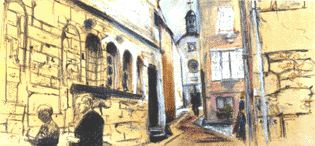|
|
|
|
|
|
|
|
|
|
|
|
|
|
|
|
|
|
|
|
|
|
|
|
|
|
|
|
|
|
|
|
|
|
|
|
|
|
|
|
|
Page 1 |
|
Page 2 |
|
|
Page 3 |
|
|
Page 4
|
|
|
|
|
|
 |
|
 |
 |
|
|
|
|
|
|
|
|
|
|
|
|
|
|
|
|
|
|
|
|
|
|
|
|
The abbey continued to grow, and on the 22nd of March, 864, the relics of St Reine were transferred to St. Pierre from Alise, since they could be more easily protected at Flavigny from what seemed to be an imminent Viking invasion. The relics were installed in the “Prison of St. Reine.” A round reliquary with a dome like the roof of a church, it is an important source of information concerning medieval architecture.
In 878, a new abbey church built on the site of the first church, was consecrated by Pope John VIII. To celebrate the occasion, the monks |
 |
|
|
|
|
|
|
|
|
|
|
|
|
|
|
|
|
|
|
|
|
|
|
|
Derrière l'Église
St Genès
(AD 91©)

|
|
|
|
|
|
|
|
|
|
|
|
|
|
|
|
|
|
|
|
|
|
|
gave the pontiff eight pounds of anis candies — at least so says a tradition reported to have been reported by several early manuscripts, which have themselves disappeared.
The Vikings arrived on January 11, 887 and established themselves below the walls of the city, which they besieged until January 25, according to Hugh of Flavigny. Eight members of the abbey community were killed. Once the Vikings had moved on (frustrated, perhaps, by the fortifications?) building resumed at a great pace, and many traces of this period of expansion are visible to this day. As the cult of relics expanded during the merovingian and carolingian periods, Flavigny became an important pilgrimage center.
Sometime between 1085 and 1092, a certain Rainald, a devote of St Prix, had the saint’s relics transferred into an elaborate reliquary decorated with gold, silver and precious stones. At the same period, the relics of St Reine were placed in a silver reliquary.
|
|
|
|
|
|
|
|
|
|
|
|
|
|
|
|
|
|
|
©
|
|
|
|
|
|
|
|
|
|
|
|
 |
|
|
|
|
|
|
|
|
|
|
dmj:020718
|
|
|
|
|
|
|
|
|
|
|
|
|
|
|
|
|
|
 Rue de l'Église .......... (AD 1991©) Rue de l'Église .......... (AD 1991©)
|
|
|
|
|
|
|
|
|
|
|
|
|
|
|
|
|
|
|
|
|
|
|
|
|
|
|
|
In the early days, Flavigny was the centre of a administrative region which covered a vaste territory: Dijon, Langres, Autun. It was an ecclesiastical fiefdom, possessing extensive legal and financial powers. The abbots of Flavigny wielded both temporal and political power and sometimes seemed to have rather more enthusiasm for these secular spheres than for spiritual matters.
The town became an important commercial centre, and local lords built townhouses here, in order to be closer to their feudal overlord, the abbot. The town was full of artisans and merchants, whose talents and interests are suggested by the large number of fine buildings constructed between the twelfth and seventeenth centuries.
|
|
|
|
|
|
|
|
|
|
|
|
|
|
|
 |
|
|
|
|
|
|
|
|
|
|
|
|
|
|
The degree to which the non-monastic side of the town had grown is demonstrated by the foundation of the parish church of St Genès in the tenth century. At about the same period, Abbot Renaud II began construction of the first fortification to surround the town as well as the abbey. These developments suggest that the town and townspeople were both prosperous and increasingly. |
|
|
|
 |
|
|
|
|
|
|
|
|
|
|

![]()
